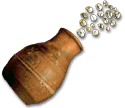Greek Currency
Lydia and the First Electrum Coins
The Greek historian Herodotus, writing in the 5th century
BC famously stated that "the Lydians were the first people we know
to have struck and used coinage of silver and gold." He is almost
correct. The earliest coins were in fact made from electrum, an alloy of
gold and silver but, on the evidence of their findspots, do seem to belong
to this part of the world. These coins had a design on one side only. On
the other, simple punches were used.
The Earliest Coin Hoard
The earliest known hoard of electrum coins (and thus the
earliest known coin hoard) was found buried in a small pot during the
British Museum's excavations of the Artemision, or Temple of Artemis
at Ephesus in 1904-05. Containing 19 coins it had been placed alongside
another 74 coins in the foundations of the temple, one of the seven wonders of
the ancient world, in about 600 BC.

A Strict Weight System
Although irregular in size and shape, these early electrum
coins were minted according to a strict weight-standard. The denominations
ranged from 1 stater (weighing about 14.1g) down through half- staters,
thirds, sixths, twelfths, 1/24ths and 1/48ths to 1/96th stater (about 0.15gm).
It cannot have been easy to tell some of the smaller denominations apart.
We must assume that for many transactions the coins were weighed rather
than counted.
The Spread of Electrum Coinage
From Lydia electrum coinage soon spread to the Greek cities of
coastal Asia Minor. From there it reached the Greeks of the islands and
the mainland. It is often difficult to tell where a particular coin
was produced, because none of these early coins was inscribed with a
place-name. Educated guesses are possible, however. One type of coin has
the design of a seal on its obverse. The Greek for seal is 'phoce' and the
coins are usually attributed to the Greek city of Phocaea.

